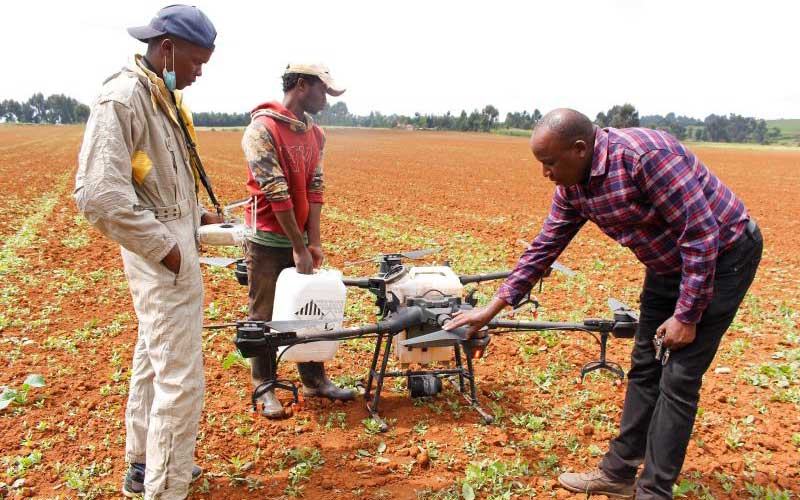Kenyan farmers in regions such as Kitui County are increasingly turning to drone technology to optimize their agricultural practices. The adoption of drones in farming operations has provided significant benefits in terms of time efficiency and cost reduction.
The journey towards integrating drones into agriculture began when drone pilot Ken Mbuki and farmer Michel Iland met at a Kenya Drone Business Competition. Both individuals shared a common need to enhance their farming activities and saw the potential of using drones.
Ken Mbuki, a business intelligence specialist, and lecturer, manages two acres of farmland in Kitui, east of Nairobi. His adoption of precision agriculture, which leverages technology like drones, GPS, and sensors, allows him to make data-driven decisions about water, fertilizer, and pesticide application. With the help of a drone, he can accurately spray his entire farm in just one hour, a task that previously required the labor of four individuals throughout the day.
Michel Iland, who owns a 170-acre piece of land in Mau-Narok, faced similar challenges before embracing drone technology. Traditional farming methods using tractors with GPS led to damage to crops, particularly wheat, due to tractors driving over the fields in the initial growth stages. However, the use of drones has reduced crop damage by approximately 40%.
Despite the significant benefits of drone-assisted farming, both Mbuki and Iland encountered a common obstacle: obtaining approval from the Kenya Civil Aviation Authority (KCAA). KCAA’s regulations required official authorization for the use of drones in agriculture. Despite persistent efforts and farm visits by KCAA officials, Mbuki’s request was denied. KCAA officials largely refrained from commenting on this issue, explaining that drone usage in farming is still a relatively new concept.
This bureaucratic hurdle presents a challenge for a new generation of farmers seeking to improve crop productivity and contribute to food security. In regions like Kitui, farmers must spray their crops at least once a week during the four-month growing season, making drone technology essential for precision agriculture.
Tabitha Kimanthi, Kitui County Senior ICT Officer, noted that Mbuki’s approach to farming using drones was a novel and technical one. The county government is considering ways to accommodate smart farming practices and establish structured guidelines.
Drones are crucial in creating detailed crop maps and assessing soil and vegetation indices, allowing farmers to monitor moisture content in the soil and identify potential stress factors affecting crop productivity. The Global Precision Farming and Agriculture Market is experiencing significant growth, highlighting the industry’s potential.
Ken Mbuki, now a certified drone pilot, shares his knowledge with fellow farmers, like Michel Iland, who has also embraced drone technology to improve his farm management. Iland envisions drones revolutionizing rice farming in Kenya, offering a solution to the labor-intensive process of pouring rice seedlings into water. Drones have not only increased yields but also reduced crop damage caused by tractors and other land-based vehicles.
Both farmers are exploring opportunities to provide drone agriculture services to other farmers in their regions, indicating the growing acceptance and potential for drone-assisted agriculture in Kenya.
The adoption of drones in Kenyan farming highlights the shift towards precision agriculture, driven by technology and data-driven decision-making. While challenges exist in terms of regulatory approval, the benefits in terms of efficiency and productivity make drone-assisted farming a compelling option for the country’s agricultural sector.




















